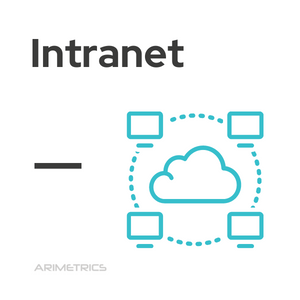Definition:
An intranet is a private network that uses Internet technology, such as the Internet Standard Protocol Suite (TCP/IP), to securely share some or all of an organization’s information and operating systems among its employees. These private networks can be used for purposes such as internal communications, file sharing and data management, collaboration or knowledge management, software and hardware support, intranet portals, search engines and other functions.
They are also used to deploy a virtual private network (VPN) and can also be useful for accessing internal websites that may contain information such as company announcements, contact information, employee directories, email services, online forms, and document sharing tools.
What is the origin of the Intranet
Intranet exists since the beginning of computing. At first it was used to connect researchers and universities within the same network, as well as between several networks. This allowed them to share information and resources more efficiently and securely. In recent decades, on the contrary, they have become increasingly popular among companies for their ability to offer a secure and unified environment for internal communications and data exchange.
This technology has also been instrumental in facilitating remote work, allowing employees to access internal resources from anywhere with an internet connection. They are now commonly used in offices around the world as a convenient and secure way for teams to collaborate on projects. Private networking technology is becoming increasingly popular in the home, as households with multiple computers or devices need a single platform for sharing files and resources. And they are already quite common in many companies because they can offer users an effective way to access documents, applications and internal tools.
What is the use of using a Document Intranet in the company
Companies need a secure and efficient way to share documents, applications and tools among their employees. Without an intranet system, businesses are at risk of data breaches due to insecure file sharing methods or lack of access control. In addition, without this system, it can be difficult for teams to collaborate on projects efficiently.
A document management system provides a secure platform for internal communications and data exchange within the company. It also enables remote work, as it provides employees with access to internal resources from anywhere with an internet connection. They offer a convenient way to access documents, applications, and tools securely, while enabling teams to collaborate more effectively on projects. They are increasingly implemented in companies, as they offer a reliable solution to manage information securely within the organization.
They are a convenient and secure way to manage internal communications and data exchange. This technology allows teams to collaborate on projects more efficiently, while providing employees with access to internal resources from anywhere with an Internet connection. They are an invaluable tool for businesses of all sizes and can offer a streamlined experience to employees working remotely or in the office.
Advantages of the Intranet
The use of an Intranet has multiple advantages for those who use it, some of these advantages are the following:
- Improved collaboration: Help teams collaborate on projects more efficiently, enabling faster communication and document sharing across the organization.
- Increased efficiency: Provides users with an effective way to access internal documents, applications, and tools quickly and securely.
- Cost savings: They can reduce IT costs by eliminating the need for expensive hardware or software solutions to manage data internally.
- Increased security: They provide a secure platform for internal communications and data exchange, reducing the risk of data leakage due to insecure file sharing methods or lack of access control.
- Remote Work Support: Allow employees to access internal resources from anywhere with an Internet connection, enabling organizations to support remote work environments more easily than ever before.
- Streamlining processes and procedures: They can be used to store important policies and procedures in a centralized location that is easy to update when needed, helping streamline processes within the organization while reducing confusion among employees regarding organizational rules and guidelines.
- Increased productivity: Intranet technology enables faster communication between employees, improving productivity across departments.
List of intranet disadvantages
Like everything, this technology also has some drawbacks when using it:
- Intranet security risks: They can be subject to security risks if not properly configured and maintained. Hackers can gain unauthorized access to data or applications due to a weak security system or lack of user authentication protocols.
- High cost of deployment and maintenance: They can be expensive to deploy and maintain, especially for large organizations with complex network infrastructure needs.
- User adoption difficulties: require users to adopt new technologies for the system to work efficiently, which can lead to challenges for employees to feel comfortable using the system effectively.
- Complex system administration: Require dedicated IT staff members who must manage system configuration, maintenance, updates, and troubleshooting processes on an ongoing basis.
- Lack of standardization between departments and organizations: They often suffer from a lack of standardization between departments and organizations, which causes inconsistencies in content management practices, document formatting standards, etc., and confuses users.
